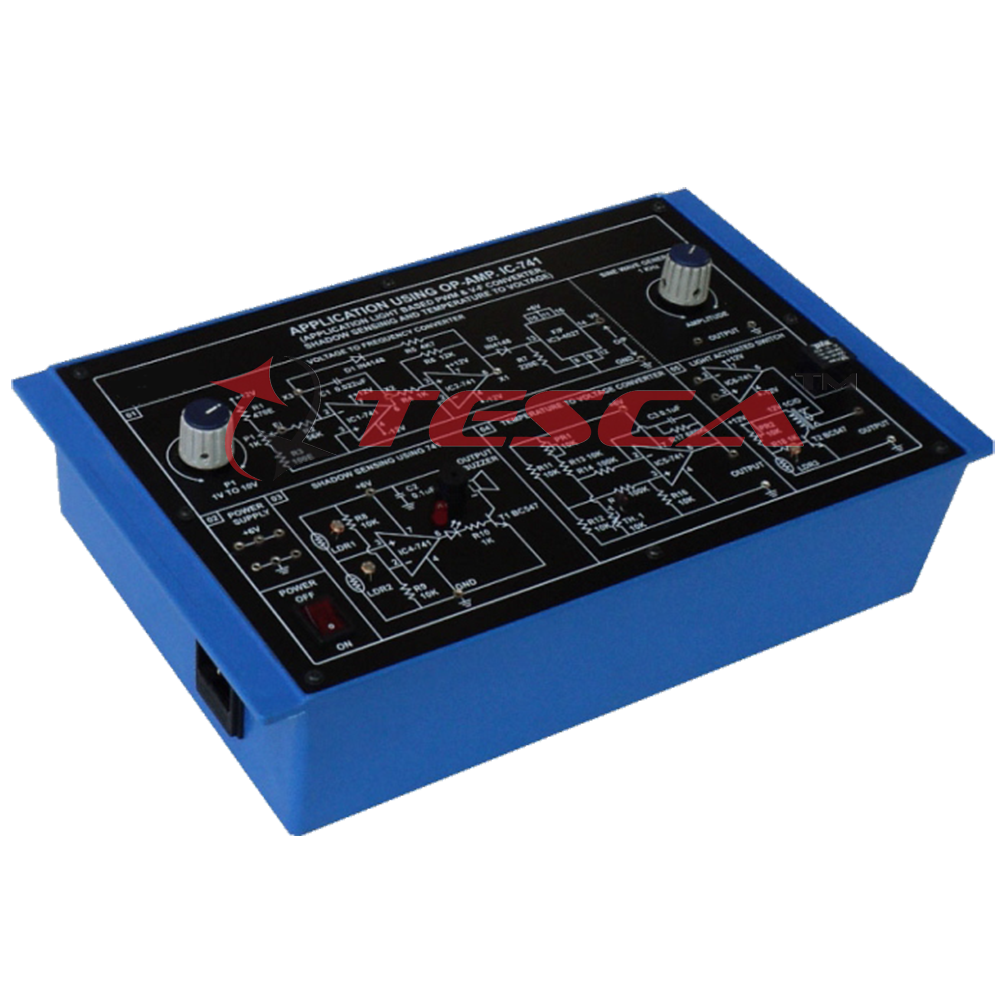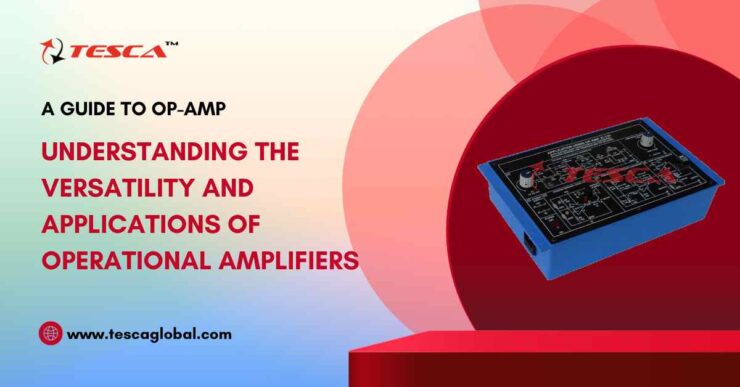Table of Contents
Do you want to avoid dealing with outdated and unreliable equipment in your electronic projects?
Look no further than the OP-Amp IC-741. This Operational Amplifier, also known as an op-amp, is a versatile and widely used integrated circuit that can amplify electrical signals in various applications. Whether working on a hobby project, prototyping a new product, or designing a commercial system, the IC-741 can provide the performance and reliability you need.
These devices are at the heart of many electronic circuits and have many applications. From amplifying weak signals to filtering and shaping them, OP-amps are an essential tool in electronics.
This blog series will explore how op amps are used in various applications, such as audio processing, instrumentation, and control systems. Whether a beginner or an experienced engineer, you’ll find valuable information on designing and using op amps in your projects. So, please sit back, relax and enjoy the journey as we delve into the world of OP-amp!
OP-AMP: Definition, Uses, Working Principle, Types, and Application
What is An OP-AMP Trainer Board?
An OP amp trainer board is an electronic circuit board used to demonstrate and teach the basic principles of operational amplifier circuits. It typically includes various components and connections that allow users to experiment with different circuit configurations and observe the resulting electrical signals and behavior. These boards are commonly used in educational settings, such as universities and technical schools, to help students learn about the fundamental concepts of electronic circuit design and analysis.
The application using the OP Amp Trainer Board includes studying the basics and applications of operational amplifiers and performing mathematical operations such as addition, subtraction, multiplication, integration, differentiation, rectification, oscillation, filtering, peak detection, comparison, and more.
The board consists of a functional generator, variable power supplies, and decade capacitor boxes. It can generate a sine wave, square wave, and triangle wave signals with a frequency range of 1Hz to 110KHz. It also has 28 test points to allow users to investigate the behavior of OP amplifiers.
Uses of an OP-AMP Trainer Board
Overall, OP-amp is a versatile and powerful device widely used in various electronic systems, and its application areas are expanding day by day with the development of technology and gadgets. Let’s see some of the primary uses of applications using OP amp Trainer Board.
- Enables In-Depth Study and Analysis of Operational Amplifiers-
The OP Amp Trainer Board is a powerful tool for students and engineers to explore and understand the fundamentals of operational amplifiers. With the board’s comprehensive set of features, users can study, analyze, and simulate various applications and circuits.
- Used as Comparators-
Op amps can also be used in comparators, which compare two voltage levels, output a signal indicating which level is higher, and filter out unwanted frequencies from a signal.
- Built-In Function Generator, Variable Power Supplies, And Decade Capacitor Boxes-
It can generate a sine wave, square wave, and triangle wave signals with a frequency range of 1Hz to 110KHz. Additionally, the board has 28 test points to allow users to investigate the behavior of OP amplifiers.
- Can Design Analog Filters-
Users can design and test activities with the board, low-pass, high-pass, band-pass, and notch filters.
- Helpful In Designing Circuits For Signal Conditioning And Instrumentation-
Users can design circuits for measuring temperature, pressure, voltage, and current for automatic gain control, rectification, and signal conversion.
Working Principle of an OP-AMP Trainer Board
Are you looking to gain a deeper understanding of operational amplifiers? Look no further than the OP Amp Trainer Board. This powerful tool is designed specifically for students and engineers, providing a comprehensive set of features allowing in-depth study and analysis of OP-amps.
The board is divided into two sections:
The Power Section includes DC power supplies, decade capacitor boxes, and the signal section, which comprises the function generator, OP-amp circuits, and test points. With these resources, users can study both the static and dynamic characteristics of OP-amps, such as open loop gain and input offset voltage, as well as output frequency response, slew rate, and settling time. But the OP Amp Trainer Board doesn’t stop there.
It also allows users to design, simulate, and analyze various circuits and applications. From active filters to oscillators, the board is an ideal tool for learning the basics and applications of operational amplifiers. Its comprehensive features allow users to design and test different circuits to understand better how op-amps work.
In short, the OP Amp Trainer Board is an essential tool for anyone seeking a comprehensive understanding of operational amplifiers. Its wide features and capabilities make it the perfect tool for students and engineers. Take advantage of this opportunity to take your knowledge of op-amps to the next level. Invest in the OP Amp Trainer Board today.
Components of an OP-AMP Trainer Board
An OP amp trainer board typically includes the following components:
- Operational amplifier (OP amp):
This is the main component of the trainer board and is used to amplify electrical signals.
- Power supply:
The trainer board may include a built-in power supply that provides the voltage and current to operate the OP amp and other components.
- Input and output terminals:
Connects external signals to the trainer board and measures the amplified output.
- Potentiometers:
These adjust the voltage and current levels on the input and output terminals.
- Circuit diagrams:
The trainer board may include diagrams that show the connections between the different components, making it easier for users to understand how the circuit works.
Additional components such as resistors, capacitors, and LEDs may also be included on the board to provide additional functionality and allow for different circuit configurations.
OP-AMP Trainer Board Setup
Are you ready to take your understanding of operational amplifiers to the next level? Look no further than the easy setup process of an OP amp trainer board.
First, connect the power supply to the board and ensure that your OP amp and other components have the voltage and current to operate. Next, set up your circuit on the board with input and output terminals, resistors, capacitors, and LEDs, using the circuit diagrams provided as a guide to ensure that all connections are made correctly.
Adjust the potentiometers to control the voltage and current levels on the input and output terminals, apply your input signal, and watch as the OP amp amplifies it for you. Analyze and compare the output signal with precision using an oscilloscope or other measurement tools. Experiment with different circuit configurations and components to gain a deeper understanding of the behavior of the OP amp under different conditions. Repeat the process with different input signal frequencies and amplitude to understand the OP-amp frequency response.
Types of OP-AMP Trainer Boards
Several types of applications can be implemented using an OP amp trainer board. Some common examples include:
1. Voltage amplifier: The OP amp can amplify an input voltage, allowing for stronger signals to be transmitted or received.
2. Current amplifier: The OP amp can amplify an input current, allowing more power to be delivered to a load.
3. Instrumentation amplifier: The OP amp can be used to amplify small signals in the presence of large common-mode signals, as in bridge sensors, thermocouples, and strain gauges
4. Oscillators: OP amps can oscillate by providing positive feedback, allowing them to generate repetitive signals.
5. Active filters: The OP amp can filter a signal by amplifying or attenuating specific frequency ranges.
6. Summing amplifier: It can combine multiple input signals into a single output signal.
7. Differential amplifier: It amplifies the difference between two input signals.
8. Power amplifier: OP amplifiers can amplify a signal’s output power, enabling higher output power.
These are just a few examples of applications that can be implemented using an OP amp trainer board. The specific application will depend on the circuit configuration and the desired outcome.
OP-AMP Trainer Board Brochure
The OP amp trainer board is a powerful tool that allows students, engineers, and hobbyists to explore and understand the fundamentals of operational amplifiers and their various applications.
Therefore, the trainer board brochure includes everything that can make you understand the process of joining and starting the boards.
The OP amp trainer board is a versatile tool for experimenting with operational amplifiers (OP amps). It can be used for various applications, including circuit design, troubleshooting, and testing.
The board includes various circuit configurations and a wide range of inputs and outputs, making testing and measuring different aspects of OP amp performance easy. Additionally, the board can teach basic circuit design and electronics concepts, making it an ideal tool for educators and students.
The brochure will provide detailed information on using the board, including diagrams and explanations of different circuit configurations and measurements.
OP-AMP Trainer Board Price:
On average, prices for bare OP amp trainer boards can range from around $50 to $150. However, prices for more advanced boards with additional features and higher-quality components can range from $200 to $500 or even more. It’s essential to research and compares different boards from various manufacturers to find the best features and value for the price. But always look at these factors before buying an OP amp trainer board.
- Components: The quality and quantity of components included on the board will affect the price. Boards with more components and higher quality components will typically be more expensive.
- Brand: Different brands have different pricing strategies, and the brand’s reputation also affects the price.
- Features: Boards with additional features such as built-in function generators, variable power supplies, and decade capacitor boxes will typically be more expensive.
- Quantity: The price of the board may also depend on the number of boards purchased. Orders for larger quantities may receive a bulk discount.
- Market demand: The demand for the product in the market also affects the price.
Additionally, it’s a good idea to compare the price of the board with similar products to make an informed decision.
Tesca Global OP-AMP Trainer Board

Tesca Global’s OP amp trainer board could be an excellent choice for several reasons:
| Quality Components | Tesca Global is known for using high-quality components in its products, ensuring a longer lifespan and better performance. |
| Comprehensive Features | Tesca Global’s OP amp trainer board may come with a comprehensive set of features, such as built-in function generators, variable power supplies, and decade capacitor boxes, allowing a more advanced and versatile learning experience. |
| Technical Support | Tesca Global may provide technical support to their customers, ensuring users have access to the information and assistance they need to successfully operate and troubleshoot their OP amp trainer board. |
| Customizable Configurations | Tesca Global’s OP amp trainer board may allow for customizable circuit configurations, which gives users the flexibility to design and test different circuits and applications. |
| Competitive Pricing | Tesca Global may offer competitive pricing for their OP amp trainer board, providing users with a cost-effective solution for learning and understanding operational amplifiers. |
| User-Friendly Design: | Tesca Global’s OP amp trainer board may have a user-friendly design that could be easy to use, making it accessible to students, engineers, and hobbyists of all levels. |
It’s always recommended to check Tesca Global’s website or contact them directly to get more information about the features and pricing of their OP amp trainer board.
Conclusion
This blog aimed to comprehensively understand the OP amp trainer board and its various applications. From the components and features of the trainer board, we highlighted some common uses, such as voltage and current amplification, oscillators, active filters, and more.
You can also see why Tesca Global’s OP amp trainer board could be a great choice. This information will help you make an informed decision when choosing an OP amp trainer board for your learning or professional needs.





Add comment